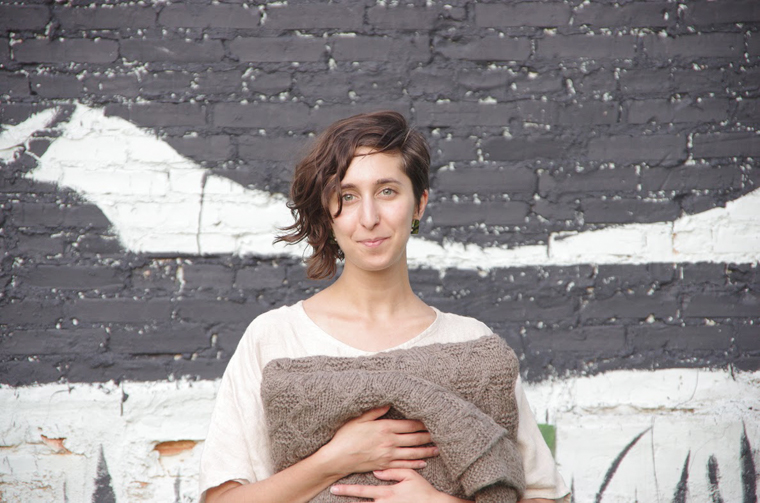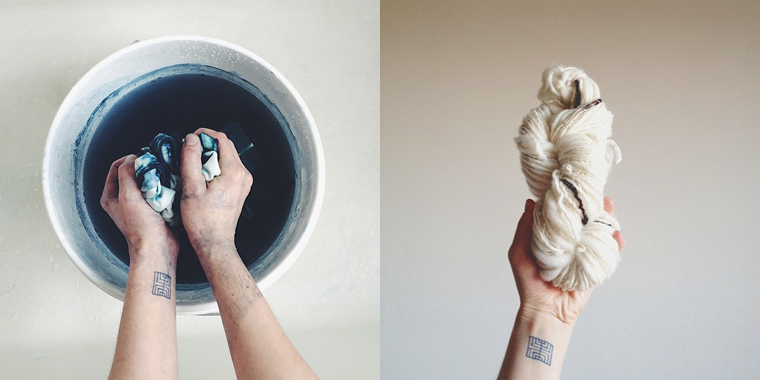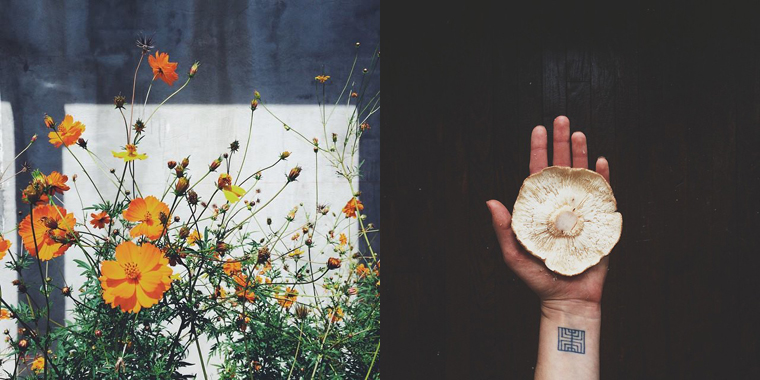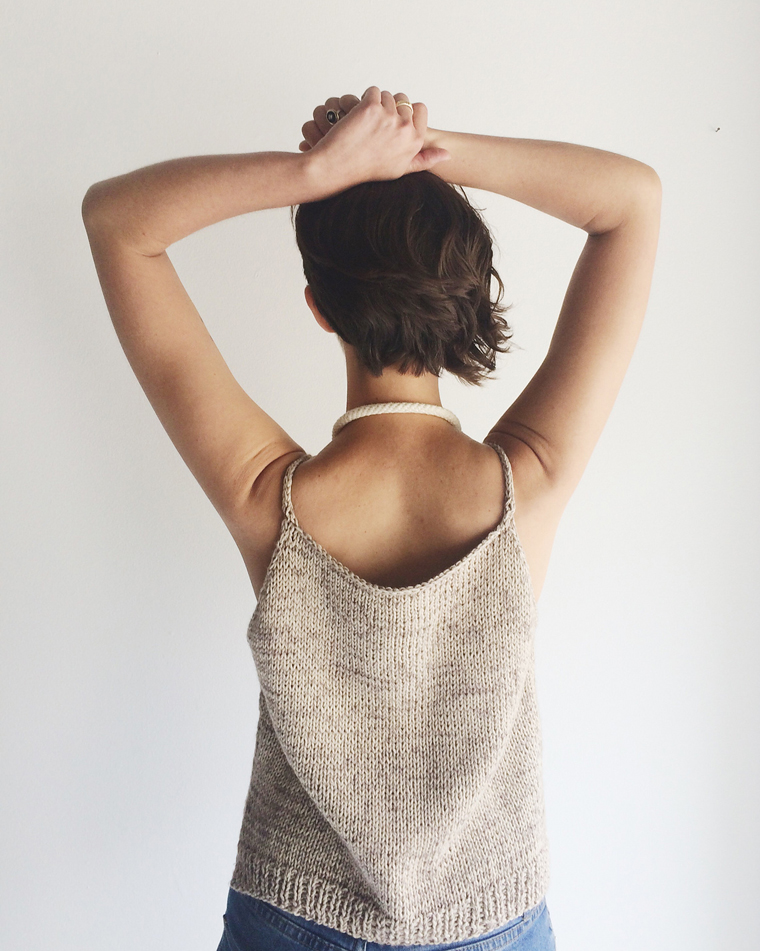 You’ve probably come across Jess Schreibstein many times. She’s written about natural dyeing in Oaxaca for Fringe Association and my fave Knit Wit magazine, she rocks both Instagram and Ravelry and also opened the very first Woolful podcast (..!). That’s already a pretty admirable rap sheet and there is a lot more.
You’ve probably come across Jess Schreibstein many times. She’s written about natural dyeing in Oaxaca for Fringe Association and my fave Knit Wit magazine, she rocks both Instagram and Ravelry and also opened the very first Woolful podcast (..!). That’s already a pretty admirable rap sheet and there is a lot more.
Maybe you’ve connected the dots, maybe not. I have to admit that I didn’t realise that it was the same awesome chick doing all that, until one fatefull Instagram post(more on that later) when I started paying more attention. Yes, I am that bad with names (and sometimes with paying attention. Sorry, not sorry). I have since made up for my mistake and in turn found an eloquent, creative and endlessly interesting woman. If I could I would take all of my vacations in Jess’s head but since that most likely wont happen(and probably isn’t considered “healthy” wishing either) I decided to contact her and see if she’d have a chat with me for this space instead. She did and we ended up having a talk about the power of ritual crafting, feeding ones creativity, accidentally designing patterns and everything in between. I know it is a bit on the long side, but I found it so interesting that I couldn’t cut it short. So instead of a quick skim, make yourself comfortable, grab a cup of your finest herbal tea and get ready for some immersion.
I’d be interested in hearing your thoughts on these subjects as well, so feel free to share in the comments!
S : Hey Jess! You do a lot of different things like Cooking, Herbals, Knitting, Dying etc. Do you feel like you have a primary craft or is the sweet spot somewhere in between all of them?
J : Week by week, or even month by month, I find that a different craft will come forward and dominate my time until another project cycles through. So sometimes, my energy will be funneled towards cooking – I had a whole year when I was spending nearly every night after work and every weekend canning jams, pickles and more. I learned a lot and loved it, but now I’m channeling that energy and using that time towards knitting and reinvigorating my painting practice.
But it’s all about balance. If you’re knitting all the time but not making time to prepare nourishing food or move your body and exercise, you may be feeding your creativity but not caring for your whole person. Also, each practice informs the other in obvious or not-so-obvious ways, so I think it’s in the interest of your creative fire to make sure you’re taking a break from the actual practice once in awhile with other activities that excite you.
S : So true! From what I’ve learned my creativity draws from the sum of my experiences. I want to keep that well pretty full. With that in mind what are you working on right now?
J : I just completed a mammoth project – the Talon blanket by Jared Flood – as a gift for a couple I love dearly. That project was a true test in endurance, taking six months to make and using nearly 2500 yards of yarn. It’s my biggest project yet and I’m pretty proud of it.
Next up on my needles are a few tunic-style sweaters I’ve been itching to make. I’m knitting Michele Wang’s Abbot with a really delicious oatmeal-colored fingering from Harrisville Designs in New Hampshire, one of a small handful of woolen mills left in the U.S. I’m also swatching for Carrie Bostick Hoge’s Lucinda with two variations – O-Wool’s 100% organic Local yarn in a cinnamon-brown for one sweater, and Quince & Co.’s Sparrow, a 100% linen yarn. I’ve never knit in linen before but the pattern seems pretty generous and forgiving, so excited to give it a try.
Lastly, I’ve been dying to cast on with my giant skein of TONOFWOOL Cormo, and think it would make the perfect Aran-style cabled scarf. I’m doing some research and putting together a few cabled patterns together to make my own design. Adding to all of this, Karen Templer just revealed her Fringe and Friends Knitalong for 2015 with a Cowichan sweater vest, and I’m tempted to abandon everything and cast on for that!
S : I initially wrote you because of an instagram post you made when you where doing a Residency at Have Company. You were guiding a Full Moon Meditation and had planned a ritual craft to go along with that. The idea of ritual crafting is so powerful to me. In a way it is why I named this space Temple of Knit. So I thought this awesome chick gets it and I have to talk to her right now! Haha. Could you tell me a bit more about that workshop, the ritual craft and your stay at Have Company?
J : So the exciting thing about that meditation is that we recorded it! Anyone can listen and follow along – new moon or any moon – and hopefully tap into some inner knowing and peace from it.
As for the craft, I blended together a variety of herbs that help induce sleep and dreaming and we tied them up in pouches as dream pillows. There was something so beautiful about having a community of 13 women – a total coincidence, but that’s the number of moons in a solar year – gathered in a circle sharing our visions from the meditation and then mindfully creating something with our hands in that sacred, healing space to take with us.
S : Do you think there is a ritual element to all crafting?
J : I love digging into the intersections between traditional craft – knitting and spinning, for example – with women’s work, spirituality, power and ritual. A ritual, by definition, is a set rhythm of activities, movements or performance enacted by a person or community in an effort to call down greater power into otherwise ordinary actions or objects. Each ritual doesn’t have to be a momentous ceremony – the simple repetition of the thing can be celebratory and instructive.
Knitting is like that for me. It is a daily practice and a meditation. It is the transformation of ordinary materials into an object of reverence. While knitting hasn’t traditionally always been women’s work, it is a practice that has been dominated by women crafters and finds opportunity to weave in spiritual or symbolic elements into the object, whether they be through the wool, colors or motifs. I find that incredibly powerful.
I also love the word “craft” and how it’s being reclaimed from its negative connotations – a baser, simpler art form made by a woman – into something that is just as worthy as any oil painting made by a man hanging on a wall of a gallery. The word “craft” makes its way into woman-dominated spiritualities too – think “witchcraft” or “spellcraft.” How cool is that? The lineage of the word already draws these roadmaps between women’s work, art, power and ritual.
S : Definitely! It is also a way to forge a deepened understanding of the material wool, the creatures and earth that it came from. That kind of connection to nature can be hard to find these days and I am so grateful for it.
When you mentioned the word craft it got me wondering whether or not it is connected to the Danish word Kraft which means power or strength. So I checked it out and it actually has the same root. It was later expanded into “a notion of mental powers”. So great! I find it amazing that these things we’re talking about, is in a way already inherent in the word, underneath layers of historical disregard. As a counterpoint to that, it probably wasn’t meant as a particularly positive thing. I imagine there is a connection between this and the word crafty (ie. sly and deceptive) and again from that to the words you mentioned spellcraft/witchcraft. Together they paint this wellknown image of a manipulative and mysterious woman who schemes and disrupts with her crazy mind powers. Whatever. That woman is my hero, she knows stuff. Have you ever read the Erica Jong book “Witches”? I stole it from my stepmom when I was a teenager and kept it as my holy bible.
J : Wow, I’ve never heard about the meaning or root of the Danish word “Kraft.” That’s really intriguing and powerful. I have not read that book, but I’ve read parts of “Women Who Run with the Wolves” by Clarissa Pinkola Estés. She walks through a host of mythologies and folk stories and surfaces some really telling female archetypes – like the trickster or the witch – and questions and upends entrenched stereotypes surrounding these identities.
S : Ooh that sounds really interesting, I love a good book recommendation. To bring it back to knitting, you recently designed and published your first pattern the Beach Tank. Is that a path you’re gonna keep on?
J : When I made the beach tank, I didn’t set out to design a pattern. I made this thing for myself and it was a fun challenge to make something without a pattern for the first time! But the reception on Instagram was so great that I decided to take a stab at it. It’s a pretty straightforward pattern, but it still presented some unique sizing challenges and went through multiple iterations and testing to get it just right.
As I continue my knitting practice, I find more and more that patterns in my head aren’t alive in the world yet. So I could see a future where I’m developing concepts and patterns.
S : It’ll be exiting to see what you come up with! I am finding it hard to end this inspiring talk so maybe we could do it this way; Do you have a favourite knitting tip or trick that you would like to leave us with?
J : One of the best things I’ve learned in the past year is to join new balls of yarn in a project at the start of a new row, and to never, ever knot your yarn. It’s easier to weave in your ends this way and creates a smoother finished product. This may seem sort of obvious to long-time knitters, but this tip was a revelation when I first heard it on the Knit.fm podcast.
I would also tell new or newish knitters to spend some time in learning how to properly block, seam and weave in ends. At the end of a project, it’s tempting to fudge these final steps so you can wear your hat or sweater or whatever, but spending a little extra time to finish the project well will really step up your work a couple notches.
All images are curtesy of Jess Schreibstein




A Conversation with Jess Schreibstein
A beautiful interview! I’ve been following Jess since her Woolful interview and she is inspiring in so many ways! Thank you for sharing!
Thank you Alina! She is indeed.
Lovely interview. I first heard about Jess on the Woolful podcast, this was a lovely complement to that. And I am checking those books out!